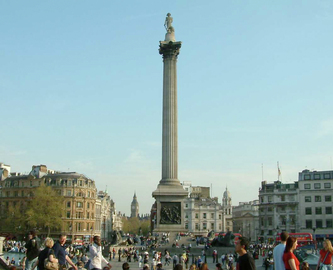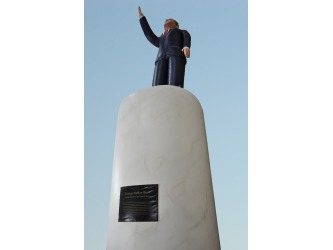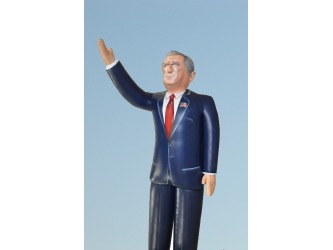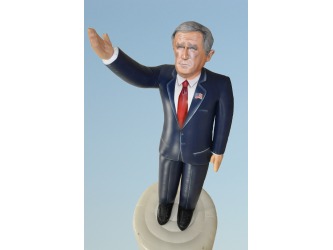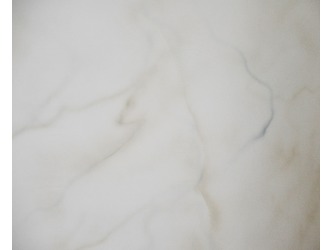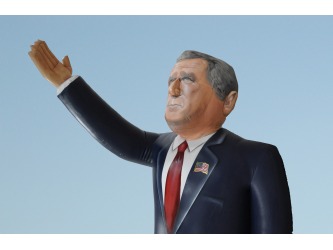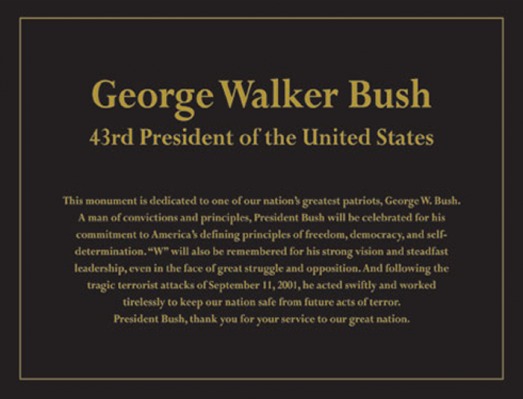Inspiration
The inspiration for this project came during a brief visit to London. As I walked through Britain’s capital city I was surrounded by monuments of events and people that meant nothing to me. I was clearly an outsider to this nation’s history. However, I could feel the powerful presence that these monuments had; these must have been important people, important events, and important causes. It was like a mass PR campaign with the overbearing message that Britain is (undeniably) a great and historic nation. In this foreign city, I realized the immense power of monuments and memorials - throughout time, monuments have been used by nations to assert power, create a common history, and acknowledge common suffering. I began to think about what is the role of monuments in a democratic society? What values should be embraced? Which specific people should be represented?
The selection of American political figures in monuments and statues is especially interesting to me. Why are some presidents selected over others? Do some presidents represent America’s values better than others? Why do some presidents deserve to be remembered on a mountainside, while others deserve only a modest bronze statue?
This begs the question: Does President George W Bush deserve a monument? And if so, what form would be most appropriate?
The selection of American political figures in monuments and statues is especially interesting to me. Why are some presidents selected over others? Do some presidents represent America’s values better than others? Why do some presidents deserve to be remembered on a mountainside, while others deserve only a modest bronze statue?
This begs the question: Does President George W Bush deserve a monument? And if so, what form would be most appropriate?
Location
How does the location of a monument influence the design and reception of it?
This project examines how the geographical, physical, and cultural landscapes/locations influence the reception of The George Bush Memorial.
I chose to unveil the monument in the city that most contributed to President Bush’s legacy, Washington D.C. In our nation’s capital viewers can see The George W Bush Monument in close proximity to the other monuments around the Mall. The Bush Monument will immediately be associated with, and compared to, the monuments of our nation’s great presidents. In creating a monument for President Bush, I wanted to physically examine Bush’s position in the historical timeline of our nation.
However, I also plan on presenting the monument at important sites that helped build his legacy. I want to shine light on the various places that may have influenced George W Bush. As a sculptor, I an interested in the relationship between these physical spaces and the presentation of the monument, the various ideas that connect the two and activate the space. These test-sites provoke the ultimate question: Where should a permanent monument for President Bush be located?
In his hometown? In Washington DC? Outside his fraternity? Outside of his church? In the oil fields of Texas?
These physical spaces all influenced George W. Bush at some point of his life, but not all are traditionally appropriate places for a Presidential Monument. However, maybe a monument for President Bush would require unique placement. For example, a group in California tried, unsuccessfully, to rename the Oceanside Water Pollution Control Plant (CA) the George W. Bush Sewage Plant.
Because the George W. Bush Monument is temporary, much of the project exists online. This poses an important question regarding monuments in the 21st Century:
What does it mean for a monument to exist online? Do humans even need physical monuments and memorials?
Much time and money is currently being spent to photograph and document monuments online, but can people really feel the power of a monument from photos on their computer screen?
This project examines how the geographical, physical, and cultural landscapes/locations influence the reception of The George Bush Memorial.
I chose to unveil the monument in the city that most contributed to President Bush’s legacy, Washington D.C. In our nation’s capital viewers can see The George W Bush Monument in close proximity to the other monuments around the Mall. The Bush Monument will immediately be associated with, and compared to, the monuments of our nation’s great presidents. In creating a monument for President Bush, I wanted to physically examine Bush’s position in the historical timeline of our nation.
However, I also plan on presenting the monument at important sites that helped build his legacy. I want to shine light on the various places that may have influenced George W Bush. As a sculptor, I an interested in the relationship between these physical spaces and the presentation of the monument, the various ideas that connect the two and activate the space. These test-sites provoke the ultimate question: Where should a permanent monument for President Bush be located?
In his hometown? In Washington DC? Outside his fraternity? Outside of his church? In the oil fields of Texas?
These physical spaces all influenced George W. Bush at some point of his life, but not all are traditionally appropriate places for a Presidential Monument. However, maybe a monument for President Bush would require unique placement. For example, a group in California tried, unsuccessfully, to rename the Oceanside Water Pollution Control Plant (CA) the George W. Bush Sewage Plant.
Because the George W. Bush Monument is temporary, much of the project exists online. This poses an important question regarding monuments in the 21st Century:
What does it mean for a monument to exist online? Do humans even need physical monuments and memorials?
Much time and money is currently being spent to photograph and document monuments online, but can people really feel the power of a monument from photos on their computer screen?
Timing
Most monuments and memorials are executed years after the fact, but I wonder if this delay is necessary? What would it mean to have an instant monument? How important is the passage of time in remembering an event or political leader? How will we remember President Bush in 15 years? 50 years?
I decided to unveil the Monument as President-elect Obama finished his oath of office, the instant President Bush officially left office (January 20, 2009 at noon). By eliminating any passage of time, I expect to test people’s raw emotional response to such a monument.
I decided to unveil the Monument as President-elect Obama finished his oath of office, the instant President Bush officially left office (January 20, 2009 at noon). By eliminating any passage of time, I expect to test people’s raw emotional response to such a monument.
Iconography
The project questions the role of iconography in shaping public perception of a monument. How do artists represent democratically elected Presidents? How does this differ from monumental representations of dictators? What is the role of memorials in a democracy compared to their role in an authoritative regime?
Inscription
How do you write a commemorative inscription for one of the most divisive and controversial presidents of all time? How can you honor the service of a president while acknowledging his shortcomings?
How do you write an inscription that speaks for the people? How can you represent people’s various opinions and create a unifying monument?
Should an inscription evolve over time, in order to reflect changing public opinion? How does the location of a monument influence the text of the inscription?
What is the responsibility of the artist? A monument should represent the figure respectfully and truthfully.
How do you write an inscription that speaks for the people? How can you represent people’s various opinions and create a unifying monument?
Should an inscription evolve over time, in order to reflect changing public opinion? How does the location of a monument influence the text of the inscription?
What is the responsibility of the artist? A monument should represent the figure respectfully and truthfully.
Customizable Inscription
In a democracy, citizens are responsible for keeping their leaders accountable and this should not end once they are out of power - citizens should have control over how their leaders are remembered. Thus, the inscription of The George W Bush Monument is adjustable, and may be replaced over time. I encourage everyone to write their own inscription for President Bush. Please write carefully and respectfully, and send them to [email protected]. I will collect these diverse inscriptions and post on the website, so people can read and reflect upon the opinions of others.
The inscription currently on the monument reads:
"George Walker Bush
43rd President of the United States
In honor of one our nation’s greatest patriots, George W. Bush. He will be remembered for his legendary conviction to America’s defining principles of freedom, democracy, and self-determination. ‘W’ will also be remembered for his strong vision and steadfast leadership, even in the face of great struggle and opposition. Following the historic terrorist attacks on September 11, 2001, he acted swiftly and worked tirelessly to keep our nation safe from future acts of terror.
President Bush, thank you for your service to our great nation. "
Suggestion from Billy Mullaney (Minneapolis, MN):
"I'm a uniter, not a divider"
George W. Bush
February 29th, 2000
The inscription currently on the monument reads:
"George Walker Bush
43rd President of the United States
In honor of one our nation’s greatest patriots, George W. Bush. He will be remembered for his legendary conviction to America’s defining principles of freedom, democracy, and self-determination. ‘W’ will also be remembered for his strong vision and steadfast leadership, even in the face of great struggle and opposition. Following the historic terrorist attacks on September 11, 2001, he acted swiftly and worked tirelessly to keep our nation safe from future acts of terror.
President Bush, thank you for your service to our great nation. "
Suggestion from Billy Mullaney (Minneapolis, MN):
"I'm a uniter, not a divider"
George W. Bush
February 29th, 2000
Thank You
Special thanks to Landmark Creations for doing a great job with the fabrication of the Monument.
Also to my family and friends that have been so supportive
And to everyone who contributes to the project and helps it evolve into a shared vision
